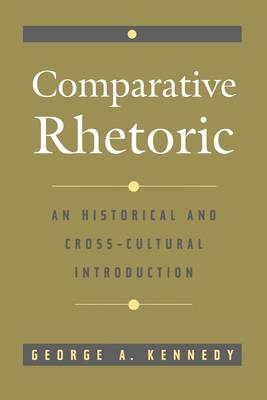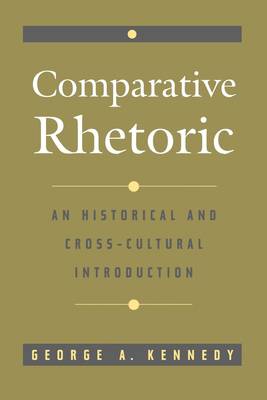
- Afhalen na 1 uur in een winkel met voorraad
- Gratis thuislevering in België vanaf € 30
- Ruim aanbod met 7 miljoen producten
- Afhalen na 1 uur in een winkel met voorraad
- Gratis thuislevering in België vanaf € 30
- Ruim aanbod met 7 miljoen producten
Zoeken
Comparative Rhetoric
An Historical and Cross-Cultural Introduction
George A Kennedy
Paperback | Engels
€ 46,45
+ 92 punten
Omschrijving
Comparative Rhetoric is the first book to offer a cross-cultural overview of rhetoric as a universal feature of expression, composition, and communication. It begins with a theory of rhetoric as a form of mental and emotional energy which is transmitted from a speaker or writer to an audience or reader through a speech or text. In the first part of the book, George Kennedy explores analogies to human rhetoric in animal communication, possible rhetorical factors in the origin of human speech, and rhetorical conventions in traditionally oral societies in Australia, the South Pacific, Africa, and the Americas. Topics discussed include forms of reasoning, the function of metaphor, and the forms and uses of formal language. The second part of the book provides an account of rhetoric as understood and practiced in early literate societies in the Near East, China, India, Greece, and Rome, identifying unique or unusual features of Western discourse in comparison to uses elsewhere. The concluding chapter summarizes the results of the study and evaluates the validity of traditional Western rhetorical concepts in describing non-Western rhetoric.
Addressing both what is general or common in all rhetorical traditions and what is unique or unusual in the Western tradition, Comparative Rhetoric is ideally suited for courses in rhetoric, rhetoric theory, the history of rhetoric, intercultural communication, linguistic anthropology, and comparative linguistics.
Addressing both what is general or common in all rhetorical traditions and what is unique or unusual in the Western tradition, Comparative Rhetoric is ideally suited for courses in rhetoric, rhetoric theory, the history of rhetoric, intercultural communication, linguistic anthropology, and comparative linguistics.
Specificaties
Betrokkenen
- Auteur(s):
- Uitgeverij:
Inhoud
- Aantal bladzijden:
- 256
- Taal:
- Engels
Eigenschappen
- Productcode (EAN):
- 9780195109337
- Verschijningsdatum:
- 21/08/1997
- Uitvoering:
- Paperback
- Formaat:
- Trade paperback (VS)
- Afmetingen:
- 168 mm x 235 mm
- Gewicht:
- 367 g

Alleen bij Standaard Boekhandel
+ 92 punten op je klantenkaart van Standaard Boekhandel
Beoordelingen
We publiceren alleen reviews die voldoen aan de voorwaarden voor reviews. Bekijk onze voorwaarden voor reviews.











